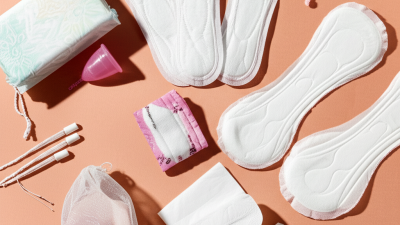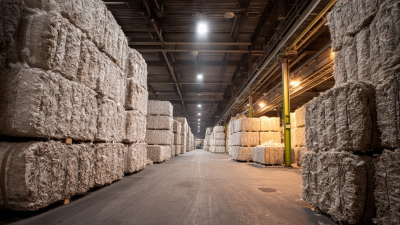
Understanding Menstrual Materials A Comprehensive Guide for Eco-Conscious Consumers
As the global conversation around sustainability intensifies, understanding Menstrual Materials has never been more crucial for eco-conscious consumers. According to a report by the World Economic Forum, approximately 45 billion menstrual products are disposed of annually, leading to significant environmental impacts due to their non-biodegradable nature. Furthermore, a study published in the Journal of Ecological Economics highlights that traditional menstrual products contribute to over 200,000 tons of waste each year in the United States alone. With an increasing awareness of the ecological footprint left by single-use products, consumers are now more inclined to explore sustainable alternatives. This comprehensive guide aims to illuminate the various categories of Menstrual Materials available, empowering individuals to make informed decisions that not only cater to their needs but also promote a healthier planet.

The Environmental Impact of Traditional Menstrual Products: Key Statistics and Insights
The environmental impact of traditional menstrual products is significant, with several studies revealing alarming statistics. For instance, it is estimated that a single menstruator uses around 11,000 to 16,000 disposable menstrual products in their lifetime. According to the World Bank, the production and disposal of these products contribute to millions of tons of waste annually, with conventional sanitary pads containing approximately 90% plastic, which can take up to 500 years to decompose.
Furthermore, research conducted by the non-profit organization "Sustainable Menstruation Australia" indicates that the carbon footprint of disposable menstrual products is equivalent to 4.1 kg of CO2 per cycle. This figure includes the emissions from manufacturing, transportation, and disposal, showcasing a significant environmental burden that can easily be alleviated through sustainable alternatives. By choosing reusable menstrual cups or organic cotton pads, consumers can drastically reduce landfill waste and lower their carbon footprint, aligning their menstrual health practices with eco-conscious values.
Understanding Menstrual Materials: A Comprehensive Guide for Eco-Conscious Consumers
| Menstrual Product | Average Usage (per cycle) | Environmental Impact | Estimated Decomposition Time | Eco-Friendly Alternatives |
|---|---|---|---|---|
| Disposable Pads | 10-15 | Contains plastic, contributes to landfill waste | 500-800 years | Cloth pads, menstrual cups |
| Tampons | 20-30 | Biodegradable but often packaged in plastic | 6 months to 5 years | Menstrual cups, organic cotton tampons |
| Menstrual Cups | 1-2 | Reusable, minimal landfill impact | Up to 10 years (with proper care) | Organic cotton pads, period underwear |
| Cloth Pads | 5-10 | Reusable, reduces waste significantly | 5 years (with proper care) | Menstrual cups, period tracking apps |
Exploring Sustainable Alternatives: A Comparison of Eco-Friendly Menstrual Materials
As eco-conscious consumers increasingly seek sustainable alternatives, the menstrual materials market is witnessing significant growth. The global biodegradable sanitary pad market is projected to rise from USD 1.26 billion in 2025 to USD 2.54 billion by 2033, indicating a robust compound annual growth rate (CAGR) that reflects the growing awareness around environmental issues. This shift is crucial not only for reducing landfill waste but also for addressing the environmental impact associated with traditional menstruation products.

Various eco-friendly options are emerging, including biodegradable pads, reusable menstrual cups, and period pants, which are designed to minimize pollution and waste. A comparative analysis of these products reveals that while reusable menstrual cups and period pants offer a more sustainable choice due to their longevity, biodegradable pads serve as a less polluting alternative to conventional sanitary products. According to recent studies, the development of starch-based bioplastics is paving the way for more sustainable packaging solutions, underscoring the potential for innovation in the menstrual materials sector that aligns with broader sustainable development goals.
Understanding Material Safety: Analyzing the Ingredients in Menstrual Products
As eco-conscious consumers increasingly seek sustainable options, understanding the safety and ingredients in menstrual products becomes paramount. Many conventional menstrual items, such as pads and tampons, contain synthetic materials and harmful chemicals. A recent report from the Environmental Protection Agency (EPA) notes that over 50% of conventional pads are made from plastics, which contribute to environmental pollution and can introduce harmful substances into the body.
Moreover, an analysis by the Women’s Health Network revealed that many mainstream feminine hygiene products contain potentially harmful chemicals, such as dioxins and fragrances. These substances are linked to various health concerns, including reproductive issues and increased risk of certain cancers. With information showing that approximately 20 billion menstrual products are disposed of annually in the U.S. alone, the need for safer alternatives has never been clearer.
Eco-conscious consumers should look for products that prioritize transparency and use organic, chemical-free materials. Brands that are certified organic or you use natural fibers, such as cotton or bamboo, can help mitigate the health risks associated with menstrual products. The market is gradually shifting towards safer and more sustainable options, as evidenced by a 2021 study from the Organic Trade Association, which reported a 22% increase in sales of organic cotton menstrual products, reflecting growing consumer awareness and demand for safer alternatives in the menstrual health space.
The Lifecycle of Menstrual Products: From Manufacturing to Disposal
The lifecycle of menstrual products is critical for eco-conscious consumers who are looking to minimize their environmental impact. A recent comparative study revealed that PLA (polylactic acid) sanitary pads have a 17 times lower environmental impact compared to traditional polyethylene alternatives. This significant reduction underscores the importance of selecting materials that not only perform well but also aid in sustainability efforts. The study suggests that choosing products made from renewable sources can substantially lower greenhouse gas emissions associated with menstrual management.
In addition to individual choices, the broader impact of menstrual policies and product design cannot be overlooked. As companies strive for more sustainable options, integrating a full life cycle assessment approach is essential. This involves considering the environmental impact at every stage—from manufacturing to disposal. Emphasizing reusable products such as menstrual cups and cloth pads can further reduce waste in landfills, as these options encourage a circular economy model. With the digital circular economy market projected to grow substantially by 2034, the shift towards more sustainable menstrual products is not just a trend but a necessary evolution in consumer health and environmental consciousness.
Consumer Trends: How Eco-Conscious Choices are Shaping the Menstrual Products Market
Consumer trends are significantly reshaping the menstrual products market, driven by a growing awareness of environmental issues. Eco-conscious consumers are increasingly prioritizing sustainable alternatives such as menstrual cups, reusable cloth pads, and organic cotton tampons. This shift reflects a collective desire to reduce waste and minimize the carbon footprint associated with traditional disposable products, which often contribute to landfill overflow and environmental degradation.
Brands are responding to this demand by innovating their product lines. Companies are now focusing on transparency in sourcing materials and adopting eco-friendly manufacturing processes. As a result, consumers are empowered to make informed choices that align with their values. The rise of subscription services for sustainable menstrual products also highlights a change in purchasing behavior, as consumers seek convenience alongside sustainability. This evolving landscape indicates a pivotal moment where eco-consciousness is not just a trend but a defining characteristic of the menstrual products industry.

Related Posts
-

Understanding the Production Standards for the Best Everyday Sanitary Pads Fiber in the Global Market
-

How to Choose the Right Menstrual Materials for a Comfortable Experience
-

How to Choose the Best Menstrual Materials for Your Comfort and Health
-

How to Choose the Best Plastic Free Sanitary Pads for Your Eco Friendly Lifestyle
-

How to Harness the Benefits of Recycled Psf Fiber in Sustainable Manufacturing
-

Top Strategies for Enhancing Durability with Polypropylene Concrete



